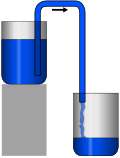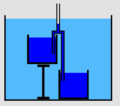Siphon
Siphon is a tube in an inverted 'U' shape, which causes a liquid to flow uphill, above the surface of the reservoir, without pumps, powered by the fall of the liquid as it flows down the tube under the pull of gravity, and discharged at a level lower than the surface of the reservoir it came from.
Principle[edit]
The siphon works because of the difference in pressure. At the upper reservoir's surface, the pressure is atmospheric pressure minus the liquid's weight above the entry point of the siphon. At the exit of the siphon, the liquid is at atmospheric pressure, because it is open to the air. The lower pressure at the top allows atmospheric pressure on the liquid at the lower reservoir to push the liquid up the tube into the lower pressure zone at the top, and then the greater weight of liquid in the longer leg pushes the liquid up and out the shorter leg to the lower reservoir.
Applications[edit]
Siphons are used in a wide variety of applications, from agriculture to the nuclear industry. They are used in irrigation and agriculture for transferring water over a hill. In the nuclear industry, they are used in fuel storage ponds to keep the fuel under water, but allow the water to be drained off in case of a leak.
History[edit]
The siphon has been used since ancient times. It was described by Hero of Alexandria in the 1st century AD, and was also used in the Hanging Gardens of Babylon and the Great Pyramid of Giza.
See also[edit]
|
|
|
Siphon[edit]
-
Lappo
-
Flying Droplet Siphon
-
Pascal's siphon
-
Chain Model Of Siphon
-
Siphon Still Works With Big Leg
-
Siphon No Tensile Strength Needed
-
Air Launch Siphon
-
Opposite And Equal Forces Not Cancelling
-
Siphoning
-
St George Cotton Irrigation
-
Siphon
-
Boardman River Dams Ecosystem Restoration
Ad. Transform your life with W8MD's Budget GLP-1 injections from $75


W8MD offers a medical weight loss program to lose weight in Philadelphia. Our physician-supervised medical weight loss provides:
- Weight loss injections in NYC (generic and brand names):
- Zepbound / Mounjaro, Wegovy / Ozempic, Saxenda
- Most insurances accepted or discounted self-pay rates. We will obtain insurance prior authorizations if needed.
- Generic GLP1 weight loss injections from $75 for the starting dose.
- Also offer prescription weight loss medications including Phentermine, Qsymia, Diethylpropion, Contrave etc.
NYC weight loss doctor appointmentsNYC weight loss doctor appointments
Start your NYC weight loss journey today at our NYC medical weight loss and Philadelphia medical weight loss clinics.
- Call 718-946-5500 to lose weight in NYC or for medical weight loss in Philadelphia 215-676-2334.
- Tags:NYC medical weight loss, Philadelphia lose weight Zepbound NYC, Budget GLP1 weight loss injections, Wegovy Philadelphia, Wegovy NYC, Philadelphia medical weight loss, Brookly weight loss and Wegovy NYC
|
WikiMD's Wellness Encyclopedia |
| Let Food Be Thy Medicine Medicine Thy Food - Hippocrates |
Medical Disclaimer: WikiMD is not a substitute for professional medical advice. The information on WikiMD is provided as an information resource only, may be incorrect, outdated or misleading, and is not to be used or relied on for any diagnostic or treatment purposes. Please consult your health care provider before making any healthcare decisions or for guidance about a specific medical condition. WikiMD expressly disclaims responsibility, and shall have no liability, for any damages, loss, injury, or liability whatsoever suffered as a result of your reliance on the information contained in this site. By visiting this site you agree to the foregoing terms and conditions, which may from time to time be changed or supplemented by WikiMD. If you do not agree to the foregoing terms and conditions, you should not enter or use this site. See full disclaimer.
Credits:Most images are courtesy of Wikimedia commons, and templates, categories Wikipedia, licensed under CC BY SA or similar.
Translate this page: - East Asian
中文,
日本,
한국어,
South Asian
हिन्दी,
தமிழ்,
తెలుగు,
Urdu,
ಕನ್ನಡ,
Southeast Asian
Indonesian,
Vietnamese,
Thai,
မြန်မာဘာသာ,
বাংলা
European
español,
Deutsch,
français,
Greek,
português do Brasil,
polski,
română,
русский,
Nederlands,
norsk,
svenska,
suomi,
Italian
Middle Eastern & African
عربى,
Turkish,
Persian,
Hebrew,
Afrikaans,
isiZulu,
Kiswahili,
Other
Bulgarian,
Hungarian,
Czech,
Swedish,
മലയാളം,
मराठी,
ਪੰਜਾਬੀ,
ગુજરાતી,
Portuguese,
Ukrainian











